Over the past couple of weeks, I talked aboutWhat is Posture- the fundamental need for stabilization to provide healthy movement; andYou Cannot Control Your Posture- postural control does not come from conscious thought. This brings up an obvious question. How do you train postural control? The answer is by integrating a full body, holistic approach to health and fitness. The program I use with my clients involvesdeep tissue massage therapywith a focus on thefascial system,self-massage using a foam roller, flexibility training, corrective exercise, functional strength training, andbarefoot or minimalist walking and running. In today's post, I will take you through the first steps (pun intended) of this process.
IT STARTS WITH THE FEET
 The feet are your connection to the Earth. They are the foundation of your posture and the platform from which you move. In Architecture, the foundation of a building provides a base of stabilization that supports the entire structure. A weak foundation leads to collapse. The same is true for your feet, with a very significant difference… you move! Your feet have thechallenging responsibilityofprovidingstrengthandstabilitywhilemaintainingflexibilityandmobilityto aid in themovementofthe entire body structure. Not a simple task!
The feet are your connection to the Earth. They are the foundation of your posture and the platform from which you move. In Architecture, the foundation of a building provides a base of stabilization that supports the entire structure. A weak foundation leads to collapse. The same is true for your feet, with a very significant difference… you move! Your feet have thechallenging responsibilityofprovidingstrengthandstabilitywhilemaintainingflexibilityandmobilityto aid in themovementofthe entire body structure. Not a simple task!
THE FEET ARE YOUR FOUNDATION
With a strong healthy posture, the body aligns over the feet. This is what provides the incredible stability from which healthy movement is derived. Just like the foundation of a building must be stable to support walls and a roof, the feet must be stable to support the legs, torso, spine and head. If your feet are weak, they are unstable. This is equivalent to building a house upon a bed of sand. The feet become misaligned and the ankles, knees, hips, back, and shoulders follow. Misalignment creates dysfunctional movement which causes pain and injury. A healthy foot is fundamental to good posture.
HOW DO WE GET THERE?
What should you do if your goal is healthy feet and good posture? Focus on developingstrength,stabilityandmobilitywhile staying grounded and connected to the Earth. A great way to do this is totake your shoes off. You can read more on why I am an advocate of making the transition to barefoot or minimalist footwear inFree Your Feet, and howshoes affect running and walking gait patterns. But before you toss your shoes and fully convert to a barefoot lifestyle there is an important step you must take. It is vital that yourebuild the strength and stabilization of the muscles of your lower leg and feet– they are likely weak fromdecades of neglect.
Remember:the feet you walk on are the very foundation of your posture. The healthier your foot care is the better your body will move and feel. Below are exercises to build strength, balance and stability in your feet and lower legs.
The following exercises will help strengthen the intrinsic muscles of your foot and leg, challenge postural muscles, and train your foot and lower leg to stabilize providing healthy movement for your entire body. I recommend doing these exercises two to three times a week for eight to twelve weeks. As your foot gets stronger you can continue to perform these exercises for maintenance on a weekly basis.
SELF-MYOFASCIAL RELEASE USING FOAM ROLLER THERAPY
By performingself-myofascial release techniques using a foam roller or ball, you canreduce trigger points, decrease tissue tension, and break down scar tissue adhesions in injuredmyofascial tissue (muscle and fascia)formed by a combination of acute trauma, poor posture, repetitive movement, over-training, or inadequate sleep. The goal of self-myofascial release is to speed up the healing and
recovery process, reduce pain, improve joint range of motion, balance the body, and prevent injury.
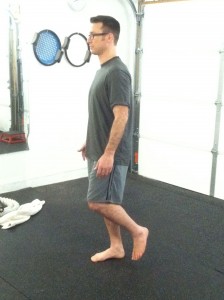
Stand on each foot for one minute. Try to keep the inside ball, outside ball, and heel of the foot in contact with the ground for the entire minute. Do not stabilize with your opposite leg.
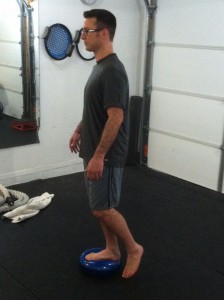
Stand on a stability disc with each foot for one minute. Do not stabilize with your opposite leg.
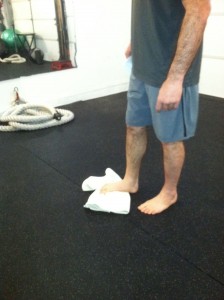
From a seated or standing position, lay a towel on the floor beneath your foot. Using your toes, grab the towel and hold it for a few seconds and release. Repeat 20 times on each foot.
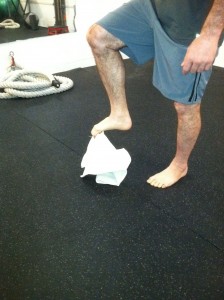
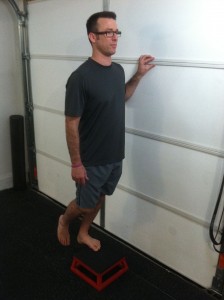
Standing with your forefoot on a platform, press through the ball of your foot lifting your heel as high as you can
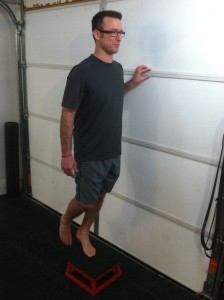
Drop our heel. Make sure as you press, you don't roll to the outside of the foot. Do 2-3 sets of 12-15.
Foot Circles(click for video)From a seated or standing position, clench your toes and do 30 circles in each direction.Single Leg Deadlift (click for video)Balancing on one leg, lift opposite heel towards the ceiling. Try to keep the inside ball, outside ball, and heel of the foot in contact with the ground. Keep your hips and shoulders parallel to the ground, don't let your hip rotate up towards the ceiling. Do 12 on each leg.The Twelve Walks (click for video)Walk using each foot position making a 10 foot circle in each direction. Example, walk on the outside of your forefoot to your left, making a 10 foot circle, then turn around and make the same 10 foot circle to your right before switching to the inside ball of your foot. There are six foot positions walked in each direction making The Twelve Walks.
IT STARTS WITH THE FEET
 The feet are your connection to the Earth. They are the foundation of your posture and the platform from which you move. In Architecture, the foundation of a building provides a base of stabilization that supports the entire structure. A weak foundation leads to collapse. The same is true for your feet, with a very significant difference… you move! Your feet have thechallenging responsibilityofprovidingstrengthandstabilitywhilemaintainingflexibilityandmobilityto aid in themovementofthe entire body structure. Not a simple task!
The feet are your connection to the Earth. They are the foundation of your posture and the platform from which you move. In Architecture, the foundation of a building provides a base of stabilization that supports the entire structure. A weak foundation leads to collapse. The same is true for your feet, with a very significant difference… you move! Your feet have thechallenging responsibilityofprovidingstrengthandstabilitywhilemaintainingflexibilityandmobilityto aid in themovementofthe entire body structure. Not a simple task!THE FEET ARE YOUR FOUNDATION
With a strong healthy posture, the body aligns over the feet. This is what provides the incredible stability from which healthy movement is derived. Just like the foundation of a building must be stable to support walls and a roof, the feet must be stable to support the legs, torso, spine and head. If your feet are weak, they are unstable. This is equivalent to building a house upon a bed of sand. The feet become misaligned and the ankles, knees, hips, back, and shoulders follow. Misalignment creates dysfunctional movement which causes pain and injury. A healthy foot is fundamental to good posture.
HOW DO WE GET THERE?
What should you do if your goal is healthy feet and good posture? Focus on developingstrength,stabilityandmobilitywhile staying grounded and connected to the Earth. A great way to do this is totake your shoes off. You can read more on why I am an advocate of making the transition to barefoot or minimalist footwear inFree Your Feet, and howshoes affect running and walking gait patterns. But before you toss your shoes and fully convert to a barefoot lifestyle there is an important step you must take. It is vital that yourebuild the strength and stabilization of the muscles of your lower leg and feet– they are likely weak fromdecades of neglect.
Remember:the feet you walk on are the very foundation of your posture. The healthier your foot care is the better your body will move and feel. Below are exercises to build strength, balance and stability in your feet and lower legs.
The following exercises will help strengthen the intrinsic muscles of your foot and leg, challenge postural muscles, and train your foot and lower leg to stabilize providing healthy movement for your entire body. I recommend doing these exercises two to three times a week for eight to twelve weeks. As your foot gets stronger you can continue to perform these exercises for maintenance on a weekly basis.
SELF-MYOFASCIAL RELEASE USING FOAM ROLLER THERAPY
By performingself-myofascial release techniques using a foam roller or ball, you canreduce trigger points, decrease tissue tension, and break down scar tissue adhesions in injuredmyofascial tissue (muscle and fascia)formed by a combination of acute trauma, poor posture, repetitive movement, over-training, or inadequate sleep. The goal of self-myofascial release is to speed up the healing and
recovery process, reduce pain, improve joint range of motion, balance the body, and prevent injury.

Stand on each foot for one minute. Try to keep the inside ball, outside ball, and heel of the foot in contact with the ground for the entire minute. Do not stabilize with your opposite leg.

Stand on a stability disc with each foot for one minute. Do not stabilize with your opposite leg.

From a seated or standing position, lay a towel on the floor beneath your foot. Using your toes, grab the towel and hold it for a few seconds and release. Repeat 20 times on each foot.


Standing with your forefoot on a platform, press through the ball of your foot lifting your heel as high as you can

Drop our heel. Make sure as you press, you don't roll to the outside of the foot. Do 2-3 sets of 12-15.
Foot Circles(click for video)From a seated or standing position, clench your toes and do 30 circles in each direction.Single Leg Deadlift (click for video)Balancing on one leg, lift opposite heel towards the ceiling. Try to keep the inside ball, outside ball, and heel of the foot in contact with the ground. Keep your hips and shoulders parallel to the ground, don't let your hip rotate up towards the ceiling. Do 12 on each leg.The Twelve Walks (click for video)Walk using each foot position making a 10 foot circle in each direction. Example, walk on the outside of your forefoot to your left, making a 10 foot circle, then turn around and make the same 10 foot circle to your right before switching to the inside ball of your foot. There are six foot positions walked in each direction making The Twelve Walks.


